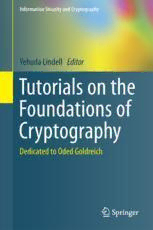Table Of ContentInformation Security and Cryptography
Editor
Yehuda Lindell
Tutorials on the
Foundations of
Cryptography
Dedicated to Oded Goldreich
Information Security and Cryptography
SeriesEditors
DavidBasin
KennyPaterson
AdvisoryBoard
MichaelBackes
GillesBarthe
RonaldCramer
IvanDamgård
AndrewD.Gordon
JoshuaD.Guttman
Christopher Kruegel
UeliMaurer
TatsuakiOkamoto
Adrian Perrig
BartPreneel
Moreinformationaboutthisseriesathttp://www.springer.com/series/4752
Yehuda Lindell
Editor
Tutorials on the Foundations
of Cryptography
Dedicated to Oded Goldreich
Editor
Yehuda Lindell
Department of Computer Science
Bar-Ilan University
Ramat Gan, Israel
ISSN 1619-7100 ISSN2197- 845X (electr onic)
Information Security and Cryptography
ISBN 978-3-319-57047-1 ISBN 978-3-319-57048-8 (eBook)
DOI 10.1007/978-3-319-57048-8
Library of Congress Control Number: 2017937580
© Springer International Publishing AG 2017
This work is subject to copyright. All rights are reserved by the Publisher, whether the whole or part of
the material is concerned, specifically the rights of translation, reprinting, reuse of illustrations,
recitation, broadcasting, reproduction on microfilms or in any other physical way, and transmission or
information storage and retrieval, electronic adaptation, computer software, or by similar or dissimilar
methodology now known or hereafter developed.
The use of general descriptive names, registered names, trademarks, service marks, etc. in this publication
does not imply, even in the absence of a specific statement, that such names are exempt from the
relevant protective laws and regulations and therefore free for general use.
The publisher, the authors and the editors are safe to assume that the advice and information in this
book are believed to be true and accurate at the date of publication. Neither the publisher nor the
authors or the editors give a warranty, express or implied, with respect to the material contained herein
or for any errors or omissions that may have been made. The publisher remains neutral with regard to
jurisdictional claims in published maps and institutional affiliations.
Printed on acid-free paper
This Springer imprint is published by Springer Nature
The registered company is Springer International Publishing AG
The registered company address is: Gewerbestrasse 11, 6330 Cham, Switzerland
ToOded,whoisacontinualinspirationtous
BennyApplebaum
BoazBarak
AndrejBogdanov
IftachHaitner
ShaiHalevi
YehudaLindell
AlonRosen
SalilVadhan
Preface
ThistutorialbookisdedicatedtoOdedGoldreichbyhisstudentsandmentoreeson
theoccasionofhis60thbirthday.ThisisanopportunetimetocelebrateOded’sfun-
damentalcontributionstothefoundationsofcryptography.Asoneofthefounders
of the field, Oded’s work has influenced the way we think about, define, and con-
struct cryptographic schemes. Oded’s research contributions are so numerous and
wide-ranging that attempting to enumerate even just the most important of them
would span many pages. Nevertheless, we would be amiss not to mention at least
Oded’s classic results on achieving pseudorandom functions, zero knowledge for
NP,securetwo-partyandmultipartycomputation,hard-corepredicatesforallone-
wayfunctions,privateinformationretrieval,lowerboundsforblack-boxsimulation,
limitationsoftherandom-oraclemethodology,obliviousRAM,andmultipledefini-
tionalworks.
Havingsaidtheabove,Oded’scontributionstocryptographyhavegonefar be-
yondhisnumerousnovelscientificresults.Inparticular,Iwouldliketoelaborateon
hisenormousinfluenceontheroleandcharacterofthefieldoftheoreticalcryptog-
raphyandwhathehastermedthefoundationsofcryptography.
AtCRYPTO’97,Odedgaveaninvitedtalk“OntheFoundationsofModernCryp-
tography”inwhichhearticulatedhisvisionforthissubfieldofcryptography.Inthe
talkandaccompanyingessay,hedescribesmoderncryptographyascomprisingdef-
initionalactivity(formulatingwhat“secure”means)andconstructiveactivity(con-
structingschemesthatfulfillthedefinitions).Furthermore,hedi(cid:11)erentiatesbetween
threetypesofresults:feasibilityresults,introductionofparadigmsandtechniques
thatmaybeapplicableinpractice,andpresentationofschemesthataresuitablefor
practicalapplications.(Ofcourse,asOdedmentionsintheessay,thefieldalsoin-
cludesotheractivitiessuchasestablishinglowerboundsandimpossibilityresults.)
ThisessayandOded’slecturenotesandseminaltwo-volumebookFoundationsof
Cryptography,havesignificantlyinfluencedthewaythatweandotherslookatand
understandourfield.Needlesstosay,therewasactiveresearchbeingcarriedouton
the foundations of cryptography before Oded published his essay. However, Oded
wasthefirsttoarticulatetheimportanceofthisworkandcreateanidentityforthis
subfieldofcryptography.
vii
viii Preface
ThesuccessofthisapproachasarticulatedbyOdedhasbeenoutstanding.Hewas
immensely influential in establishing a flourishing research community devoted to
studyingthefoundationsofcryptographyandthefundamentalquestionsoutlinedin
his1997essay.OdedwasoneofthefoundersoftheTheoryofCryptographyCon-
ferencein2004(togetherwithMihirBellareandShafiGoldwasser),andchairedits
steeringcommitteefrom2006to2012.Althoughmanycryptographytheorypapers
arepublishedatothervenues,theTCCconferencegrewunderOded’sleadershipto
beanaturalhomeforsuchwork.
Theimportanceofthisapproachandtheresearchcarriedoutonthefoundations
ofcryptographyhasintrinsicscientificvalue,relatedtothetheoryofcomputersci-
enceingeneral.Thequestionsaskedarefundamentalinnatureandofimportance,
irrespectiveofanyspecificapplication.However,inhisessay,Odedalsodiscussed
the eventual utility of theoretical cryptography to practical constructions, and this
has been unequivocally demonstrated. One example of this utility is the fact that
allnewproposedstandardsformodesofencryption,signatures,key-exchangepro-
tocols, and so on are accompanied with a proof of security. However, a far more
striking illustration is the transition of purely theoretical notions to tools that are
frequentlyusedbytheappliedcryptographyandsecuritycommunities.Onepartic-
ularlyinterestingexampleisthepaper“Towardsatheoryofsoftwareprotectionand
simulationbyobliviousRAMs”publishedbyOdedatSTOC1987(andlatermerged
intoasinglejournalpaperwithRafiOstrovsky).Thispaperintroducedanewtheo-
reticalnotionandconstructionandisaclearexampleofwhatonewouldcall“pure
theory” today. Three decades later, oblivious RAM is a widely studied primitive,
frombothatheoreticalandpracticalperspective.PapersonobliviousRAMarepub-
lishedatthetopsecurityconferencesand constructionsareimplemented.Further-
more,thetheoreticalmodelofasecureprocessorwithexternalmemoryisexactly
themodelthatIntelhasadoptedinitsnewSGXarchitectureandisonethatalsofits
manycloudcomputingscenarioswherestorageisheldexternally.Theintroduction
of this notion three decades ago, and the proof of feasibility provided back then,
informedtheappliedcryptographyandsecuritycommunitiesandformedthebasis
theyneededwhenthisconceptbecameofpracticalinterest.
Due to the great importance of the “foundations approach” to the field, Oded
didnotstopatwritingashortessay.Rather,healsodistributedwidelyusedlecture
notes, and expanded these into the two-volume treatise Foundations of Cryptog-
raphy (published by Cambridge University Press in 2001 and 2004, respectively).
This work presented a truly comprehensive “bottom-up” approach, starting from
minimalassumptionsandworkinguptoconstructhigher-levelprimitivesandappli-
cations.ItisimportanttonotethatmanyoftheresultsappearingintheFoundations
ofCryptographywereneverfullyprovenpriortothework(mostnotably,thosein
thechapteronsecurecomputation),andthusthisinvolvedamonumentale(cid:11)ort.In
fact,newresultswereuncoveredinthisprocess,includinganexactformulationof
the su(cid:14)cient assumptions for obtaining oblivious transfer and noninteractive zero
knowledge.
ThetwovolumesoftheFoundationsofCryptographyarethemostusedbookson
mybookshelf,andareanabsolutenecessityinmyresearch.Thebooksalsoprovide
Preface ix
studentsandbeginningresearcherswiththeabilitytoentertheworldoftheoretical
cryptography.Icannotimaginehowonewouldlearnthetopicofzeroknowledgein
depth without Chapter 3 of the Foundations of Cryptography, and likewise all the
othertopicscovered.
Itisthereforemostappropriatethat,incelebrationofOded’s60thbirthday(and
20 years since the publication of that essay), we present a book in his honor that
focuses on the foundations of cryptography. The chapters in this book consist of
tutorialsthatareinspiredbythe“foundationsofcryptography”approach:
Chapter1– Garbled Circuits as Randomized Encodings of Functions: a Primer
(Benny Applebaum): Yao’s garbled circuit construction is a central crypto-
graphictoolwithnumerousapplications.Thischapterreviewsgarbledcircuits
fromafoundationalpointofviewundertheframeworkofrandomizedencod-
ingoffunctions,includingpositiveandnegativeresultsandasampleofbasic
applications.
Chapter2–TheComplexityofPublic-KeyCryptography (BoazBarak):Thischap-
tersurveyswhatisknown(andthemanythingsthatarenotknown)aboutthe
computational assumptions that can enable public-key cryptography, and the
qualitativedi(cid:11)erencesbetweentheseassumptionsandthosethatareknownto
enableprivate-keycryptography.
Chapter3 – Pseudorandom Functions: Three Decades Later (AndrejBogdanov
andAlonRosen):Pseudorandomfunctionsareanextremelyinfluentialabstrac-
tion,withapplicationsrangingfrommessageauthenticationtobarriersinprov-
ingcomputationalcomplexitylowerbounds.Thischaptersurveysvariousincar-
nationsofpseudorandomfunctions,givingself-containedproofsofkeyresults
fromtheliterature.
Chapter4–TheManyEntropiesinOne-WayFunctions (Iftach Haitner and Salil
Vadhan):Thischapterintroducestworecentcomputationalnotionsofentropy,
showsthattheycanbeeasilyfoundinanyone-wayfunction,andusesthemto
present simpler and more e(cid:14)cient constructions of pseudorandom generators
andstatisticallyhidingcommitmentsfromone-wayfunctions.
Chapter5–HomomorphicEncryption (ShaiHalevi):Fullyhomomorphicencryp-
tionisarelativelynewdiscoveryandhasgainedmuchattention.Thischapter
providesatutorialonthetopic,fromdefinitionsandproperties,toconstructions
andapplications.
Chapter6–HowtoSimulateIt — A Tutorial on the Simulation Proof Technique
(Yehuda Lindell): The simulation paradigm is central to cryptographic def-
initions and proofs. This chapter consists of a systematic tutorial on how
simulation-basedproofswork,fromsemanticsecuritythroughzeroknowledge
andfinallysecurecomputation.
Chapter7–TheComplexityofDi(cid:11)erentialPrivacy (SalilVadhan):Di(cid:11)erentialpri-
vacyisatheoreticalframeworkforensuringtheprivacyofindividual-leveldata
when performing statistical analysis of privacy-sensitive datasets. The goal of
thischapteristoconveythedeepconnectionsbetweendi(cid:11)erentialprivacyand
avarietyofothertopicsincomputationalcomplexity,cryptography,andtheo-
reticalcomputerscienceatlarge.
x Preface
Oded has quoted his mother as saying “there are no privileges without duties”,
and this is a message that Oded has also infused into his students by his personal
example.IfeelgreatlyprivilegedtohavehadOdedasmyPh.D.advisor,andIam
surethatthesameistrueofalltheauthorsofthisbook(andmanyotherswhoOded
hasadvisedandmentoredovertheyears).Thisprivilegeindeedcomeswithduties.
We hope that the tutorials in this book are helpful to those who are interested in
pursuing the foundations of cryptography approach, and as such will constitute a
verysmallpartofthefulfillmentofourobligations.
In the name of all the authors of this book, I would like to wish Oded a very
happy 60th birthday. There is great happiness in being able to look back at a life
fullofaccomplishments,toseethepositiveinfluencethatyouhavehadonsomany
people,andtoappreciatethecontinuinginfluenceyourworkwillhaveinthefuture.
Happybirthday!
Israel, YehudaLindell
April2017
Contents
1 GarbledCircuitsasRandomizedEncodingsofFunctions:aPrimer:: 1
BennyApplebaum
1.1 Introduction.............................................. 1
1.2 DefinitionsandBasicProperties............................. 4
1.3 FeasibilityResults......................................... 10
1.4 AdvancedConstructions ................................... 19
1.5 Applications ............................................. 31
1.6 SummaryandSuggestionsforFurtherReading ................ 35
1.7 Appendix:RandomizedEncodingsVersusGarblingSchemes[26] 37
References..................................................... 38
2 TheComplexityofPublic-KeyCryptography ::::::::::::::::::::: 45
BoazBarak
2.1 Introduction.............................................. 45
2.2 Private-KeyCryptography .................................. 49
2.3 Public-KeyCryptography:anOverview ...................... 55
2.4 TheTwo“Mainstream”Public-KeyConstructions.............. 56
2.5 AlternativePublic-KeyConstructions ........................ 61
2.6 IsComputationalHardnesstheRuleortheException? .......... 67
References..................................................... 69
3 PseudorandomFunctions:ThreeDecadesLater ::::::::::::::::::: 79
AndrejBogdanovandAlonRosen
3.1 Introduction.............................................. 80
3.2 Definitions............................................... 87
3.3 GenericConstructions ..................................... 92
3.4 Instantiations............................................. 99
3.5 Transformations ..........................................110
3.6 ComplexityofPseudorandomFunctions ......................120
3.7 Distinguishers ............................................126
3.8 ContemporaryConstructions................................139
xi

